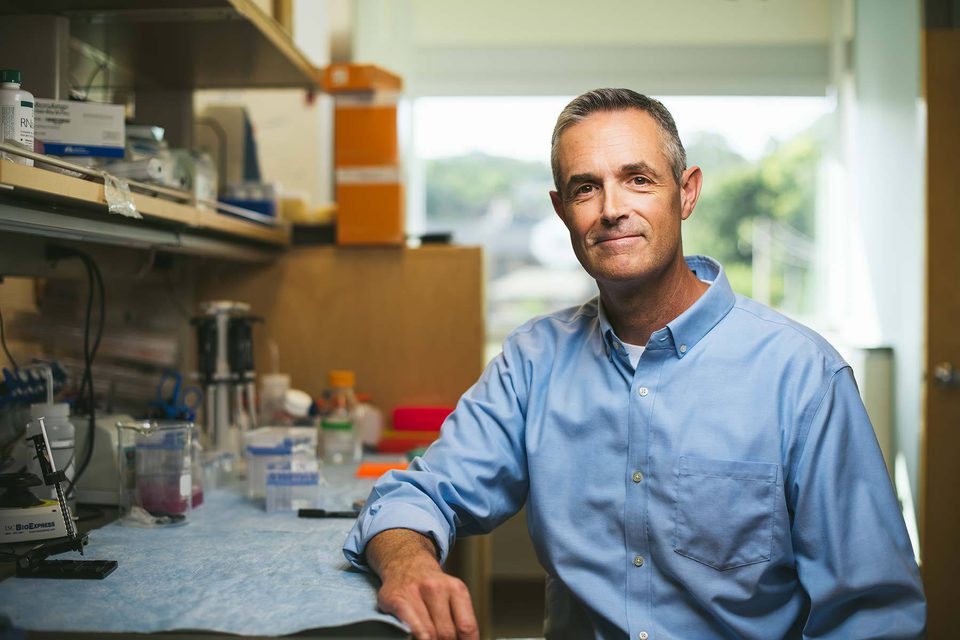Dr. David Peters: Developing Prenatal Tests that are Safer, Less Invasive

Genomics researcher, Dr. David Peters, tackles a new world with fewer needles and more saved lives
I felt that any risk of aborting a perfectly normal baby because of a diagnostic procedure was unacceptable. And that’s what really motivated me to explore alternatives.
Dr. David Peters
As a young scientist, David Peters was focused on the brain – more specifically, brain aneurisms as researched through the lens of high-throughput genomics.
But when his wife became pregnant with the first of their two children, his world – both as a husband and a scientist – dramatically changed course.
A native of England, Peters came to the University of Pittsburgh in the mid-1990s for post-doctoral research in human genetics. For about six years, he ran a lab that took a global view of biological systems – largely aneurisms, but with some study of oncology – through a genomic perspective: How do cells regulate themselves? How does DNA sequence variation impact that regulation? How do these relate to disease and disease risk?
Genomics was a relatively new science, so “it was a bit off the wall,” he admits.
But it was his experience as an expectant father that changed the course of his career.
He repatriated to the United Kingdom in 2004, after his wife underwent an amniocentesis test during her first pregnancy. Commonly used today, amniocentesis is a procedure with risks since needles drawing out amniotic fluid cause 1 in 150 women to miscarry their otherwise healthy babies.
“I was surprised and pretty horrified at the rate of fetal loss from invasive prenatal testing,” he recalls. “I felt that any risk of aborting a perfectly normal baby because of a diagnostic procedure was unacceptable. And that’s what really motivated me to explore alternatives.”
Despite a second amniocentesis procedure with her second pregnancy, his wife and their two children emerged without complication. But Peters’ scientific curiosity was piqued – so much so that he switched from studying aneurisms and cancer to developing prenatal tests that did not use a needle as part of the diagnostic procedure.
It was this work that brought him back to the U.S. and to Magee-Womens Research Institute. For Peters, the idea of doing work that went directly to the patient, where he could witness the impact on their lives, was intriguing.
Returning to Pittsburgh also represented an opportunity to explore an interesting scientific problem. At the time, the field had determined that placental DNA from the unborn baby’s genome floats around and is detectable, and recoverable, from maternal plasma. If a lab draws the mother’s blood and spins the cells out, the remaining plasma contains what Peters refers to as “a whiff of fetal DNA.”
Using computational analysis via a model created by statistician Tianjiao Chu, Peters was able to painstakingly search for the baby’s DNA, a proverbial needle, in the haystack of the mother’s plasma – although the DNA is so similar that Peters says a more accurate comparison would be like looking for “a needle in a stack of needles.”
They successfully managed to identify Down syndrome, and they proved that their test would work in any disorder involving a whole chromosome change. In 2011, Peters’ lab became the first to use the technology to identify an entire class of smaller anomalies. And they found that it could also apply across a wide range of diseases.
“When you have a way of thinking about disease, or detection of disease, you have a toolkit of things that are quite useful. It would be a shame not to use them” in as many diseases as possible, Peters says.
He remembers when he was back in England, in a gray office, looking out the window at a brick wall through pouring-down rain. He mulled whether he should change the course of his career by moving to the United States. It would mean uprooting his family, asking his wife to quit her job in England, all to pursue work that had a high failure rate — not necessarily a guaranteed career move for a developing academic scientist.
But he also thought about the thousands of healthy pregnancies that could continue to term if he succeeded — pregnancies that would lead to children living productive, healthy lives. He told himself: “If we’re going to do this, it’s going to be a different track: it will be high-risk, high-yield.”
That’s how it still feels, even a decade and several success stories later.
“You’re always failing. You spend your entire life failing. And then you get these little blips of: ‘OK, that’s a win.’ Failure, failure, failure – little tiny win. And you’re hoping that the wins get bigger,” he says. And when the solution comes, he says, “it’s just bloody obvious … it’s always easy in hindsight.”
Be the First to Know
Get the latest research, news, events, and more delivered to your inbox.